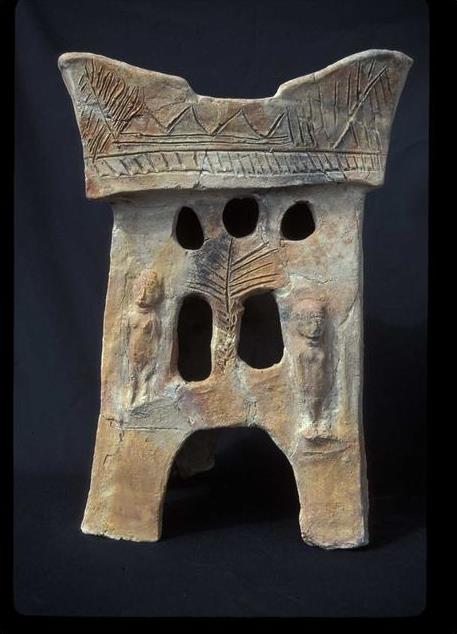Cult Stands, 12th-10th century BCE
Tel Rehov Cult Stand
Ceramic boxes or towers decorated with architectural elements and cultic images including naked females, trees, bulls, lions, and cherubs probably functioned in the cult. Each example displays architectural elements indicating a single or multi-storey structure with windows and a flat roof. Cultic symbols, either modeled in the round, incised in the clay, or cut-out, adorn the sides but the flat roof was the locus of activity. As opposed to model shrines where the inner space served as the focal point, the interior of cult stands shows no signs of use and any activity transpired on the top or roof of the stand. All excavated examples date to the 12th or 10th century BCE, likely before the establishment of the Jerusalem Temple, from the northern Jezreel and Beth Shan Valley sites of Megiddo, Ta’anach, and Tel Rehov.
Lacking material evidence of function, such as burning or burnt residue on the “roof,” we must infer the use of the stand from its shape, iconography, and various contexts. These stands appear to model and replicate a cultic activity that transpired on a building rooftop. Regarding the iconography, all the incised and modeled features, with the exception of the architectural elements, figure in the cult. On each example, as well as on all registers of the multi-storied examples, cherubs, lions, sphinxes or naked females flank either an opening or a cultic image. Sphinxes flank the Megiddo stand façade, and sphinxes and lions alternate in the successive registers of the Ta’anach stands. From the bottom register up, lions flank a nude female, cherubs frame an empty space, lions border a decorative tree flanked by feeding animals, and in the top register architectural columns frame a quadruped with a winged sun disc above its back. At actual temples, monstrous animals flanked the entrance to the contemporary Ain Dara Temple and the Bible describes the columns Boaz and Yachin to either side of the Jerusalem Temple entrance (I Kgs 7-21). Cherubs and lions likely guarded the temple entrance; the role of the naked females flanking a tree depiction on the Tel Rehov stand is not clear. On the smaller of the two Ta’anach stands the beasts frame a figure or empty space in each of the four registers. The identity of each of the central figures is contested. Each register may depict a different deity- Astarte (or Asherah) stands as the naked female with her associated lions, the empty space indicates Yahweh for whom no image may be made, the tree represents Asherah, and the bull calf stands for Baal or El. Alternatively, in alternating registers, the naked female and tree may depict Asherah and the empty space and bull stand for Yahweh. Whatever the identity of each central figure, all have explicitly cultic referents so the stand and its functioning should be considered cultic. Stands have been retrieved in excavations from a possible cultic context (Megiddo) as well as from non-cultic structures (Megiddo) and discarded in the bottom of a cistern (Ta’anach).
Based on available evidence, these stands replicate temples or shrines and may have served as a base or pedestal for an image or replicate the roof on which, according to the Bible, activities such as burning incense transpired. The lack of burnt residue suggests offerants placed the burning incense in a bowl set atop the stand.
Cult Stands and the Bible
No biblical word exists for “cult stand”; these objects were likely considered incense burners. To worship Yahweh, Israelites burned incense to gain divine attention to one’s prayers. We learn of burning incense on rooftops from condemnation of offerings directed to deities other than Yahweh. King Josiah of Judah (640-609 BCE) tore down previous kings’ altars to foreign gods erected on the roof (II Kings 23-12). Jeremiah foretold the divine punishment of those not faithful to Yahweh’s covenant and the destruction of “all the houses on the roofs of which offerings were made to the whole host of heaven and libations were poured out to other gods” (Jeremiah 19-13). The deities depicted on the various stands, Yahweh, Asherah, and perhaps Astarte and Baal, presumably indicate the intended recipient(s) of Israelite offerings. These stands, in addition to biblical condemnation of the worship of Asherah, inscriptions invoking “Yahweh and his asherah,” and perhaps the Judean Pillar Figurines, attest to a female deity as the object of Israelite devotion.
For additional details of the Taanach cult stands see A. Glock, “Taanach” NEAEHL IV- 1428-33 and P. Beck, “Cult Stands from Taanach” pp. 352-81 in Israel Finkelstein and Nadav Na’aman eds. From Nomadism to Monarchy, Archaeological and Historical Aspects of Early Israel. Yad Izhak Ben-Zvi, Israel Exploration Society, and Biblical Archaeology Society, 1994.
Elizabeth Bloch-Smith
See also-





